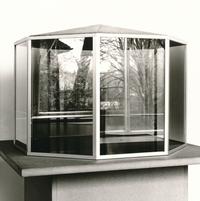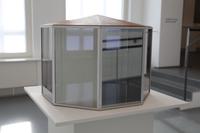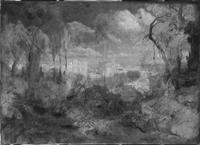Conservation
The conservation activities at the Kunstmuseen Krefeld aim to preserve its rich collection for future generations. To this end, the museum engages in a continual process of active and preventative conservation measures. Every day our conservators address the challenges posed by the multitude of mixed materials and artistic techniques in a collection spanning the late Middle Ages to the present and which includes design objects dating back centuries. Our conservators are responsible for extensively documenting the condition of the items and conducting art technological tests. They monitor the conservation conditions in the exhibitions, storerooms and during transport. Implementing practical conservation and restoration measures is a central task of their occupational profile.
The conservation work at the Kunstmuseen Krefeld is carried out in consultation with an international network of conservators. The research on the material composition and production process of the artworks and the interdisciplinary collaboration with experts and researchers ensures a steady influx of art technological and conservational expertise, which is communicated to the visiting public through subject-related tours, lectures and publications.
Dan Graham, Octogon for Münster
Originally created by Dan Graham as a model for an accessible outdoor sculpture, the work Octogon for Münster (1986) has been in the collection of the Kunstmuseen Krefeld for three decades. Within Dan Graham’s oeuvre, the object belongs to the group of two-way mirror pavilions. The phenomenon of reflection and transparency, which can be experienced in everyday life on store windows and train windows, is translated here by Graham into an autonomous, artistic concept. The complex optical interplay of multiple reflections is evoked by the spatial, octagonal arrangement of panes of semi-transparent mirror glass that reflect the exterior space while allowing one to see through the interior. The work consists of eight panes of two-way, semi-transparent mirror glass. At the top and bottom, the panes rest in aluminum U-profile strips. The roof and the central support post located inside are made of wood.
The blackening of the mirror glass caused by oxidation thwarted the artist’s intended concept. In the course of the preparatory investigations, it became clear that the damage caused by the oxidation phenomena could not be restored. How then should one deal with the mirror glass, which is characteristic of the design but functionally impaired? Is the authenticity of the object linked to the preservation of the original panes or their materiality? Or is the model still authentic if the same functionality and aesthetics are provided with new panes that equally fulfill the original material properties?
Thanks to financial support from the state of North Rhine-Westphalia and in collaboration with the restorer Julia Giebeler and the Dan Graham Studio, it was possible to develop a solution for the conservation of the damaged material surfaces. All decision-makers ultimately prioritized replacing the glass in order to restore the function of the artwork, which is directly linked to the specific mirror phenomena. Dan Graham had his long-time assistant Gary Woodley authorize the replacement of the original panes with an optically equivalent special glass. Woodley also supported the practical implementation and was available as a contact person.
Following restoration, the Octogon for Münster in the collection of the Kunstmuseen Krefeld can now be experienced again in an authentic form. The archiving of the original panes allows, if necessary, a reconstruction to the material structure existing before the restoration. The documentation of the decision-making processes represents an important resource for future conservation measures.



Adolf Höninghaus, Blick auf Rom
The Kunstmuseen Krefeld own a significant collection of drawings, aquarelles, oil studies and four oil paintings on canvas by the painter Adolf Höninghaus (1810, Krefeld – 1882, Krefeld). Höninghaus studied at the Düsseldorf Art Academy under Johann Wilhelm Schirmer. His work is situated in the context of the early Düsseldorf School of Painting. The oil studies, procured from the artists’ estate, are mostly plein-air studies he painted on various trips and during his grand tour of Italy. Back at his studio, several of these studies served as models for the final versions of his canvas paintings. In preparation of our retrospective on works by Adolf Höninghaus in 2017, curators had the opportunity to carry out art technological analyses as part of larger scale conservation measures. These analyses were conducted in part with technical support provided by the Cologne Institute of Conservation Sciences at the TH Köln – University of Applied Sciences.
Among the small-format oil studies which Höninghaus completed during his extended visit in Italy from 1844 to 1848, researchers were able to identify two direct models for his painting Blick auf Rom (View of Rome) which he produced many years later in 1871. Furthermore, researchers found evidence that the artist did not simply use the studies as a general template, but integrated specific details into his final composition. The infrared reflectography of the painting revealed that the underlying sketch and the subsequent artistic execution of the buildings at the centre of the painting almost exactly corresponded to the small preliminary studies. The sketch in this area was apparently done with a fine-pointed pen which ensured precise lining. Working from there, Höninghaus composed the other sections freely and combined them with the integrated images. In Blick auf Rom the foreground contains monumental ruins overgrown with rich vegetation. In contrast to the precise integration of the models at the centre, these freely composed sections were more casually sketched with a brush or broad-tipped drawing pen. Several variances and changes resulting from the technical aspects of the painting process are also evident in these freely composed sections. In the underlying sketch, for example, researchers discovered several figures sitting on a log. This detail was not included in the later version of the canvas painting. The analysis of the paint layers in some sketches and paintings revealed that Höninghaus’s colour palette was practically identical to that used in both his oil studies and his painting from 1871. Comparing sections of his studies completed during his trip to Italy and his painting Blick auf Rom produced some 25 years later, researchers determined that the pigment composition of the paint mixtures was almost exactly identical. One can assume, therefore, that the painter must have noted the proportions of the paint mixture in order to mix them in the same fashion in his studio years later. The impressive artistic precision demonstrated in the detailed transposition of the preliminary studies to the painting even corresponds to the exact reproduction of the paint mixtures in his studio.
![Position of the transposed studies [Untitled (Southern Ruins) and Untitled (Roman Colosseum)] in the painting Blick auf Rom (photo: Volker Döhne)](https://d1c0wt3y8v1c0a.cloudfront.net/media/attachments/W1siZiIsIjVmMDMzZjkxYmI5ZmEyMDAzMWY4ZjM3NSJdLFsicCIsInRodW1iIiwiMjAweD4iLHsiZm9ybWF0IjoianBnIiwib3V0cHV0X29wdGlvbnMiOnsiUSI6NzV9fV1d/BlickaufRom_mitStudien.jpg?sha=dba3009ab879fdef)

